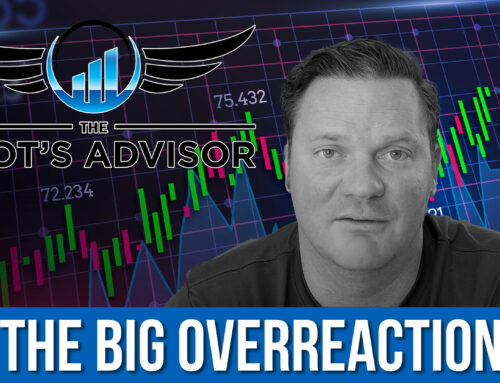4 THINGS YOU SHOULDN’T DO RIGHT NOW
U.S. stocks ended a defensive week in the red as investor sentiment deteriorated in the face of fresh worries out of China. For the week, the S&P 500 fell 5.77%, the Dow lost 5.82%, and the NASDAQ slid 6.78%.[1]
When markets take a dive, it’s natural to worry about what’s happening and where markets will go next. However, part of being a stock investor is taking market swings in stride. Now is the time to stay cool-headed and focused on your long-term goals. On that note, here are 4 things that you definitely should not do after last week’s market pullback:
Don’t listen to the talking heads. The selloff is happening in the middle of a seven-year bull market. As of Friday, the S&P 500 has gone 1,418 calendar days without a 10%+ drop (between 10/3/11 and 8/21/15).[2] Regardless of what the media is saying, the S&P 500 is down just 7.51% since its peak in mid-May.[3] Markets experienced a similar selloff in September and October of last year. However, the talking heads have taken this widely anticipated pullback and made it sound like 2008 all over again. Remember, the media’s goals are not aligned with yours. They want to keep viewers glued to their televisions and newspapers, waiting for the sky to fall. Out in the real world, we’re taking a look at the numbers behind the selloff and making prudent adjustments where we feel it’s necessary.
Don’t panic and hit the eject button. Corrections are a normal part of market cycles. Since 1927, the S&P 500 has experienced pullbacks of 5% or more about every 3.5 months.[4] While the past can’t predict the future, research shows that panicking and exiting the market is often the worst thing you can do when markets swing. Investors are notoriously terrible at picking market tops and bottoms; since periods of high growth often occur during turbulent times, investors who sell off and sit on the sidelines frequently miss out on the good days.
For example, an investor who stayed fully invested in the S&P 500 between 1995 and 2014 would have experienced a 9.8% annualized return. However, if they had traded in and out of the market, missing just the 10 best days of the market, their return would have plummeted to just 6.1%. Six of the 10 best days of the S&P 500 fell within two weeks of the 10 worst days.[5]
Don’t think like a day trader instead of an investor. Stock markets are driven by fear and greed. Right now, traders are in full-on fear mode and are selling off indiscriminately at any hint of bad news. Long-term investors are taking a look around and seeing what opportunities the pullback is offering.
Don’t get complacent. Pullbacks offer you the chance to ask yourself if you’re honestly prepared for a correction. If you have a prudent strategy and a well-diversified portfolio, then you’re better prepared for a potential correction. We don’t know whether the current selloff is a short-term blip that will reverse in a few days or the beginning of a deeper slide. However, domestic indicators are trending positively, and we believe that there is room for a resurgence.
We are keeping a very close eye on markets worldwide and will update you as needed during the evolving situation. While we can’t predict where markets will go in the next days and weeks, we focus on helping clients manage their wealth in many market environments.
ECONOMIC CALENDAR:
Tuesday: S&P Case-Shiller HPI, New Home Sales, Consumer Confidence
Wednesday: Durable Goods Orders, EIA Petroleum Status Report
Thursday: GDP, Jobless Claims, Pending Home Sales Index
Friday: Personal Income and Outlays, Consumer Sentiment
 Notes: All index returns exclude reinvested dividends, and the 5-year and 10-year returns are annualized. Sources: Yahoo! Finance and Treasury.gov. International performance is represented by the MSCI EAFE Index. Corporate bond performance is represented by the DJCBP. Past performance is no guarantee of future results. Indices are unmanaged and cannot be invested into directly.
Notes: All index returns exclude reinvested dividends, and the 5-year and 10-year returns are annualized. Sources: Yahoo! Finance and Treasury.gov. International performance is represented by the MSCI EAFE Index. Corporate bond performance is represented by the DJCBP. Past performance is no guarantee of future results. Indices are unmanaged and cannot be invested into directly.
Weekly jobless claims rise more than expected. The number of Americans filing new claims for unemployment benefits rose more than projected last week, though the underlying trend is consistent with continued labor market improvement and the previous week’s claims were revised downward.[6]
Housing starts boom. Groundbreaking on new homes rose in July to the highest level in nearly eight years. Builders ramped up activity on single-family homes, indicating that they expect significant demand later this year.[7]
Inflation rises steadily. A measure of inflation, the general increase in the cost of goods and services, rose slightly in July, supporting expectations of an interest rate hike this year.[8]
Existing home sales rocket to eight-year high. Resales of U.S. homes increased more than expected in July, rising 2.0%, and indicating that the housing market has legs.[9]
These are the views of Platinum Advisor Marketing Strategies, LLC, and not necessarily those of the named representative, Broker dealer or Investment Advisor, and should not be construed as investment advice. Neither the named representative nor the named Broker dealer or Investment Advisor gives tax or legal advice. All information is believed to be from reliable sources; however, we make no representation as to its completeness or accuracy. Please consult your financial advisor for further information.
Investing involves risk including the potential loss of principal. No investment strategy can guarantee a profit or protect against loss in periods of declining values.
Diversification does not guarantee profit nor is it guaranteed to protect assets.
The Standard & Poor’s 500 (S&P 500) is an unmanaged group of securities considered to be representative of the stock market in general.
The Dow Jones Industrial Average is a price-weighted average of 30 significant stocks traded on the New York Stock Exchange and the NASDAQ. The DJIA was invented by Charles Dow back in 1896.
The Nasdaq Composite is an index of the common stocks and similar securities listed on the NASDAQ stock market and is considered a broad indicator of the performance of stocks of technology companies and growth companies.
The MSCI EAFE Index was created by Morgan Stanley Capital International (MSCI) that serves as a benchmark of the performance in major international equity markets as represented by 21 major MSCI indexes from Europe, Australia and Southeast Asia.
The Dow Jones Corporate Bond Index is a 96-bond index designed to represent the market performance, on a total-return basis, of investment-grade bonds issued by leading U.S. companies. Bonds are equally weighted by maturity cell, industry sector, and the overall index.
The S&P/Case-Shiller Home Price Indices are the leading measures of U.S. residential real estate prices, tracking changes in the value of residential real estate. The index is made up of measures of real estate prices in 20 cities and weighted to produce the index.
The 10-year Treasury Note represents debt owed by the United States Treasury to the public. Since the U.S. Government is seen as a risk-free borrower, investors use the 10-year Treasury Note as a benchmark for the long-term bond market.
Opinions expressed are subject to change without notice and are not intended as investment advice or to predict future performance.
Past performance does not guarantee future results.
You cannot invest directly in an index.
Consult your financial professional before making any investment decision.
Fixed income investments are subject to various risks including changes in interest rates, credit quality, inflation risk, market valuations, prepayments, corporate events, tax ramifications and other factors.
By clicking on these links, you will leave our server, as they are located on another server. We have not independently verified the information available through this link. The link is provided to you as a matter of interest. Please click on the links below to leave and proceed to the selected site.
- http://finance.yahoo.com/q/hp?s=%5EGSPC&a=07&b=17&c=2015&d=07&e=21&f=2015&g=d
http://finance.yahoo.com/q/hp?s=%5EDJI&a=07&b=17&c=2015&d=07&e=21&f=2015&g=d
http://finance.yahoo.com/q/hp?s=%5EIXIC&a=07&b=17&c=2015&d=07&e=21&f=2015&g=d - Source: Mike Higley, By The Numbers (8/17/15)
- S&P 500 performance between 5/21/15 and 8/21/15
http://finance.yahoo.com/q/hp?s=%5EGSPC&a=02&b=3&c=2015&d=07&e=23&f=2015&g=d - http://investing.covestor.com/2014/08/often-investors-expect-5-market-corrections
- http://uk.businessinsider.com/cost-of-missing-10-best-days-in-sp-500-2015-3?r=US&IR=T
- http://www.foxbusiness.com/economy-policy/2015/08/20/weekly-jobless-claims-rise-more-than-expected/
- http://www.cnbc.com/2015/08/18/us-housing-starts-july-2015.html
- http://www.cnbc.com/2015/08/19/us-consumer-price-index-rose-july-2015.html
- http://www.foxbusiness.com/economy-policy/2015/08/20/existing-home-sales-rise-to-eight-year-high-in-july/








